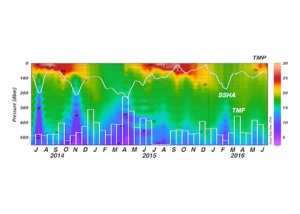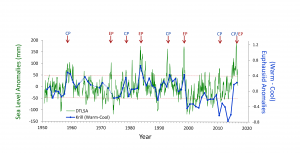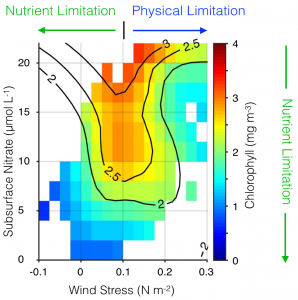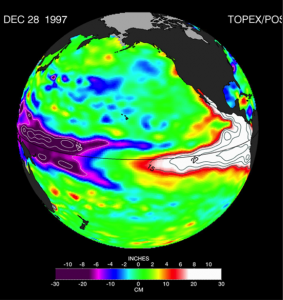
The North Pacific eastern boundary upwelling system is one of the most ecologically productive, economically relevant, and well-studied systems in the world. Over the last 60 years, a wide range of observations have documented the significant impacts of the El Niño Southern Oscillation (ENSO) on marine ecosystems along the US West Coast. Yet there has been no systematic attempt to use this knowledge to explicitly forecast local marine ecosystem responses to individual ENSO events.
A recent workshop co-sponsored by US CLIVAR, OCB, NOAA, PICES, and ICES, Forecasting ENSO impacts on marine ecosystems of the US West Coast, attempted to develop a framework for using ENSO forecasts from climate and statistical models in order to predict changes in key components of the marine ecosystem in the California Current System.
This set of articles published jointly between OCB and US CLIVAR (in their newsletter Variations) features participants from the workshop, including biologists and physical climate scientists, who were involved in advancing the discussion and outcomes. After describing a strategy to understand and quantify the predictable components of the ecosystem response to ENSO along the US West Coast (DiLorenzo and Miller), this issue discusses the need to identify target ecosystem indicators or populations that respond to ENSO and are societally relevant, such as exploitable species that are regulated by federal and state agencies (Ohman et al.).
A major challenge for understanding the predictability of targeted ecosystem indicators is identification of the dominant regional physical, biogeochemical, and lower trophic processes that carry the ENSO predictable response in the marine ecosystem (Jacox et al.; Anderson et al.). These processes are sensitive to the different flavors of ENSO teleconnections originating in the tropical Pacific (Capotondi et al.). Exploiting ENSO predictability dynamics can add skill to current seasonal forecasts of large marine ecosystems in the California Current (Tommasi et al.) and improve existing modeling tools for managing top predators (Hazen et al.).
Watch the associated webinar here, click here for compiled PDF of articles.
Dongxiao Zhang1,2, Meghan F. Cronin2, Xiaopei Lin3, Ryuichiro Inoue4, Andrea J. Fassbender5, Stuart P. Bishop6, Adrienne Sutton2 1. University of Washington 2. NOAA Pacific Marine Environmental Laboratory 3. Ocean University of China, China 4. Japan Agency for Marine-Earth Science and Technology, Japan 5. Monterey Bay Aquarium Research Institute 6. North Carolina State University Western […]
Read MoreAlison R. Gray1, Jaime Palter2 1. University of Washington 2. University of Rhode Island Estimates of contemporary global air-sea carbon dioxide (CO2) flux (Takahashi et al. 2009; Landschützer et al. 2014) suggest that subtropical western boundary currents (WBCs) and their zonal extensions are key regions of oceanic carbon uptake (Figure 1a). These narrow, intensified currents, which […]
Read MoreWBC Series Guest Editors: Andrea J. Fassbender1 and Stuart P. Bishop2 1. Monterey Bay Aquarium Research Institute 2. North Carolina State University Western boundary current (WBC) regions are often studied for their intensity of air-sea interaction and mesoscale variability, yet research addressing the implications of these characteristics for biogeochemical cycling has lagged behind. WBCs, and […]
Read MoreKeith B. Rodgers1, Ping Zhai1, Daniele Iudicone2, Olivier Aumont3, Brendan Carter4, Andrea J. Fassbender5, Stephen M. Griffies6, Yves Plancherel7, Laure Resplandy8, Richard D. Slater1, Katsuya Toyama9 1. Princeton University 2. Stazione Anton Dohrn, Italy 3. Sorbonne Universités, LOCEAN/IPSL, France 4. University of Washington 5. Monterey Bay Aquarium Research Institute 6. NOAA Geophysical Fluid Dynamics Laboratory […]
Read MoreBo Qiu1, Eitarou Oka2, Stuart P. Bishop3, Shuiming Chen1, Andrea J. Fassbender4 1. University of Hawaii at Manoa 2. The University of Tokyo 3. North Carolina State University 4. Monterey Bay Aquarium Research Institute After separating from the Japanese coast at 36°N, 141°E, the Kuroshio enters the open basin of the North Pacific, where it […]
Read MoreSophie Clayton1, Peter Gaube1, Takeyoshi Nagai2, Melissa M. Omand3, Makio Honda4 1. University of Washington 2. Tokyo University of Marine Science and Technology, Japan 3. University of Rhode Island 4. Japan Agency for Marine-Earth Science and Technology, Japan Western boundary current (WBC) regions are largely thought to be hotspots of productivity, biodiversity, and carbon export. […]
Read MoreThe US West Coast eastern boundary upwelling system supports one of the most productive marine ecosystems in the world and is a primary source of ecosystem services for the US (e.g., fishing, shipping, and recreation). Long-term historical observations of physical and biological variables in this region have been collected since the 1950s (e.g., the CalCOFI […]
Read MoreEl Niño-Southern Oscillation (ENSO) events activate long-distance teleconnections through the atmosphere and ocean that can dramatically impact marine ecosystems along the West Coast of North America, affecting diverse organisms ranging from plankton to exploitable and protected species. Such ENSO-related changes to marine ecosystems can ultimately affect humans in many ways, including via depressed plankton and […]
Read MoreThe El Niño–Southern Oscillation (ENSO) is a dominant driver of interannual variability in the physical and biogeochemical state of the northeast Pacific, and, consequently, exerts considerable control over the ecological dynamics of the California Current System (CCS). In the CCS, upwelling is the proximate driver of elevated biological production, as it delivers nutrients to the […]
Read MoreThe El Niño-Southern Oscillation (ENSO) is the dominant mode of tropical Pacific climate variability at interannual timescales, with profound influences on seasonal weather and ecosystems worldwide. In particular, the physical and biological conditions along the US West Coast, an area that supports one of the most productive marine ecosystems in the world, are strongly influenced […]
Read More







